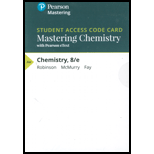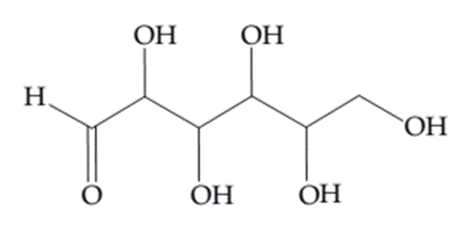
CHEMISTRY-MASTERINGCHEMISTRY W/ETEXT
8th Edition
ISBN: 9780135204634
Author: Robinson
Publisher: PEARSON
expand_more
expand_more
format_list_bulleted
Concept explainers
Question
Chapter 23, Problem 23.6A
Interpretation Introduction
Interpretation:
The number of chiral centers in glucose and the number of isomers that exists as a result of chiral centers needs to be determined.

Concept introduction:
Chiral centers are atoms with tetrahedral molecular geometry and four different substituent groups.The formula to calculate the number of isomers from the number of chiral centers is,
Where, n is the number of chiral centers.
Expert Solution & Answer
Want to see the full answer?
Check out a sample textbook solution
Students have asked these similar questions
Draw a stepwise mechanism for the following reaction.
OH
Help with annotating the labeled peaks in the 'H NMR (solvent CDCls) spectra and 'H NMR (solvent Acetone-D6) spectra Also help with Calculating the keto-enol tautomerization Ka constant for the product in both solvents.Two solvents and two different Ka
Draw a Haworth projection of a common cyclic form of this monosaccharide
CH₂OH
HO
H
HO
H
H
OH
CH₂OH
Chapter 23 Solutions
CHEMISTRY-MASTERINGCHEMISTRY W/ETEXT
Ch. 23 - Prob. 23.1PCh. 23 - Prob. 23.2ACh. 23 - Prob. 23.3PCh. 23 - Prob. 23.4ACh. 23 - Prob. 23.5PCh. 23 - Prob. 23.6ACh. 23 - Draw a complete electron-dot structure for...Ch. 23 - Limonene is the major component in the oil of...Ch. 23 - Draw an orbital overlap picture for methyl a mine...Ch. 23 - Prob. 23.10A
Ch. 23 - Draw an orbital overlap picture for formaldehyde,...Ch. 23 - Prob. 23.12ACh. 23 - Prob. 23.13PCh. 23 - Prob. 23.14ACh. 23 - Prob. 23.15PCh. 23 - Draw complete electron-dot structures from the...Ch. 23 - Prob. 23.17PCh. 23 - Prob. 23.18ACh. 23 - Draw a simplified orbital overlap picture of...Ch. 23 - Prob. 23.20ACh. 23 - Prob. 23.21PCh. 23 - Prob. 23.22ACh. 23 - Prob. 23.23PCh. 23 - Prob. 23.24ACh. 23 - Prob. 23.25PCh. 23 - Prob. 23.26ACh. 23 - Asparagine is a naturally occurring aminoacid that...Ch. 23 - Prob. 23.28PCh. 23 - Prob. 23.29PCh. 23 - Prob. 23.30CPCh. 23 - Prob. 23.31CPCh. 23 - Prob. 23.32CPCh. 23 - Prob. 23.33CPCh. 23 - Prob. 23.34CPCh. 23 - Prob. 23.35CPCh. 23 - The following structure is a representation of...Ch. 23 - Prob. 23.37CPCh. 23 - Prob. 23.38CPCh. 23 - Prob. 23.39CPCh. 23 - Prob. 23.40SPCh. 23 - Prob. 23.41SPCh. 23 - Draw a straight-chain alkane with 6 carbon atoms...Ch. 23 - Prob. 23.43SPCh. 23 - Prob. 23.44SPCh. 23 - Prob. 23.45SPCh. 23 - The following line drawings represent two amino...Ch. 23 - Prob. 23.47SPCh. 23 - Prob. 23.48SPCh. 23 - Prob. 23.49SPCh. 23 - Prob. 23.50SPCh. 23 - Prob. 23.51SPCh. 23 - Prob. 23.52SPCh. 23 - Prob. 23.53SPCh. 23 - Prob. 23.54SPCh. 23 - Prob. 23.55SPCh. 23 - Prob. 23.56SPCh. 23 - Prob. 23.57SPCh. 23 - Prob. 23.58SPCh. 23 - Give a line drawing and molecular formula for the...Ch. 23 - Prob. 23.60SPCh. 23 - Prob. 23.61SPCh. 23 - Prob. 23.62SPCh. 23 - Prob. 23.63SPCh. 23 - Prob. 23.64SPCh. 23 - Prob. 23.65SPCh. 23 - Draw the complete electron-dot structure and...Ch. 23 - Prob. 23.67SPCh. 23 - Prob. 23.68SPCh. 23 - Prob. 23.69SPCh. 23 - Prob. 23.70SPCh. 23 - Prob. 23.71SPCh. 23 - Prob. 23.72SPCh. 23 - Prob. 23.73SPCh. 23 - Prob. 23.74SPCh. 23 - Prob. 23.75SPCh. 23 - Prob. 23.76SPCh. 23 - Prob. 23.77SPCh. 23 - Prob. 23.78SPCh. 23 - Prob. 23.79SPCh. 23 - Prob. 23.80SPCh. 23 - Prob. 23.81SPCh. 23 - Prob. 23.82SPCh. 23 - Prob. 23.83SPCh. 23 - Prob. 23.84SPCh. 23 - Prob. 23.85SPCh. 23 - Prob. 23.86SPCh. 23 - What does it mean to say that fats and oils are...Ch. 23 - Prob. 23.88SPCh. 23 - Prob. 23.89SPCh. 23 - Prob. 23.90SPCh. 23 - Prob. 23.91SPCh. 23 - Prob. 23.92SPCh. 23 - Prob. 23.93SPCh. 23 - Prob. 23.94SPCh. 23 - Prob. 23.95SPCh. 23 - Prob. 23.96SPCh. 23 - Prob. 23.97SPCh. 23 - Prob. 23.98SPCh. 23 - Prob. 23.99SPCh. 23 - Prob. 23.100SPCh. 23 - Prob. 23.101SPCh. 23 - Prob. 23.102SPCh. 23 - Prob. 23.103SPCh. 23 - Prob. 23.104SPCh. 23 - Prob. 23.105SPCh. 23 - Prob. 23.106SPCh. 23 - Prob. 23.107SPCh. 23 - Prob. 23.108SPCh. 23 - Prob. 23.109SPCh. 23 - Prob. 23.110SPCh. 23 - Prob. 23.111SPCh. 23 - Prob. 23.112SPCh. 23 - Prob. 23.113SPCh. 23 - What amino acids do the following abbreviations...Ch. 23 - Name and draw the structures of amino acids that...Ch. 23 - Identify the amino acids present in the following...Ch. 23 - Prob. 23.117SPCh. 23 - Prob. 23.118SPCh. 23 - Prob. 23.119SPCh. 23 - Prob. 23.120SPCh. 23 - Prob. 23.121SPCh. 23 - Prob. 23.122SPCh. 23 - Prob. 23.123SPCh. 23 - Prob. 23.124SPCh. 23 - Prob. 23.125SPCh. 23 - Prob. 23.126SPCh. 23 - Prob. 23.127SPCh. 23 - Prob. 23.128SPCh. 23 - Prob. 23.129SPCh. 23 - Prob. 23.130SPCh. 23 - Prob. 23.131SPCh. 23 - Prob. 23.132SPCh. 23 - Prob. 23.133SPCh. 23 - Prob. 23.134MPCh. 23 - Prob. 23.135MPCh. 23 - Cytochrome c is an important enzyme found in the...Ch. 23 - Prob. 23.137MPCh. 23 - Prob. 23.138MP
Knowledge Booster
Learn more about
Need a deep-dive on the concept behind this application? Look no further. Learn more about this topic, chemistry and related others by exploring similar questions and additional content below.Similar questions
- Can you explain how I get these here and show the steps plz?arrow_forwardGive the IUPAC name for this compound Hydrocarbon Condensed Formulas Hint C2H5 CH2CH3 expand that in all the formula Part A: (CH3)2CHCH(C2H5)CH2CH2CH3 Give the IUPAC name for this compound. Part B: CH2=C(C2H5)CH2CH2CH3 Give the IUPAC name for this compound. Part C: (CH3)2C=CHC(C2H5)=CH2 Give the IUPAC name for this compound. Part D: CH3C=CCH(C2H5)2 Give the IUPAC name for this compound. Part E: (CH3)3CC=CCH2CH=C(CH3)2arrow_forwardSelect/ Match the correct letter from the image below for the IUPAC names given below: A B C D 3 E F G H K L Part 1. 4-methylheptane For example.mmmm Answer Letter H _for part 1 Part 2. 2,4-dimethylhexane Part 3. 2,3-dimethylpentane Part 4. 2,2-dimethylhexane Part 5. 2-ethyl-1,1,3,3-tetramethylcyclopentane Part 6. 3-ethyl-2-methylpentanearrow_forward
- Can u show the process as to how to get these?arrow_forwardSketch the expected 'H NMR spectra for the following compound. Label all of the H's in the structure and the corresponding signal for the spectra you sketch. Make sure you include the integration value and the splitting pattern for each signal Indicate how many signals you would expect in the 13C NMRarrow_forwardUse IUPAC naming rules to name the following hydrocarbon compounds: CH2-CH3 | a) CH-CH-CH2-CH-CH-CH3 b) | CH2 CH3 | CH3 CH3 \ / C=C H 1 H CH2-CH3 c) d) CH=C-CH3 e) CH3-CH2-CH2-CH=CH-CH3 f) CH2=CH-CH2-CH=CH-CH3 g) CH3-CH2-C = C-CH2-CH3 h)arrow_forward
- Q5 Name the following : a. b. C. d. e.arrow_forward25. Predict the major product of the following reaction. 1 equivalent of each of the starting materials was used. H₂C CH3 CH3 H3C H3C H3C. CH2 + H3C. heat CH3 CH H.C. CH3 H.C H.C CH3 CH CH3 CH3 A B C Earrow_forwardFind chemical structures based on the below information. a) Chemical formula C6H8O Compound is aromatic plus has two 1H NMR peaks that integrated for 3 each that are singlets (it could have more peaks in the 1H NMR b) Chemical Formula: C6H100 Compounds is conjugated 'H NMR has a signal that integrates for 6 and is a doublet IR spectra has a signal at 1730 cm-1arrow_forward
- Jaslev Propose a synthesis of the following starting from benzene and any other reagents and chemicals. No mechanisms are required. Indicate the condition for each step plus the major product for each step. More than two steps are required. Step 1 Step 2 مہد Brarrow_forwardPart C: The line formula for another branched alkane is shown below. i. In the IUPAC system what is the root or base name of this compound? ii. How many alkyl substituents are attached to the longest chain? iii. Give the IUPAC name for this compound.arrow_forwardPart D: Draw the Structural Formula for 4-ethyl-2-methylhexane Part E. Draw the Structural Formula for 1-chloro-3,3-diethylpentane (Chloro = Cl)arrow_forward
arrow_back_ios
SEE MORE QUESTIONS
arrow_forward_ios
Recommended textbooks for you
 General, Organic, and Biological ChemistryChemistryISBN:9781285853918Author:H. Stephen StokerPublisher:Cengage Learning
General, Organic, and Biological ChemistryChemistryISBN:9781285853918Author:H. Stephen StokerPublisher:Cengage Learning Organic And Biological ChemistryChemistryISBN:9781305081079Author:STOKER, H. Stephen (howard Stephen)Publisher:Cengage Learning,Chemistry: Matter and ChangeChemistryISBN:9780078746376Author:Dinah Zike, Laurel Dingrando, Nicholas Hainen, Cheryl WistromPublisher:Glencoe/McGraw-Hill School Pub Co
Organic And Biological ChemistryChemistryISBN:9781305081079Author:STOKER, H. Stephen (howard Stephen)Publisher:Cengage Learning,Chemistry: Matter and ChangeChemistryISBN:9780078746376Author:Dinah Zike, Laurel Dingrando, Nicholas Hainen, Cheryl WistromPublisher:Glencoe/McGraw-Hill School Pub Co Chemistry & Chemical ReactivityChemistryISBN:9781133949640Author:John C. Kotz, Paul M. Treichel, John Townsend, David TreichelPublisher:Cengage Learning
Chemistry & Chemical ReactivityChemistryISBN:9781133949640Author:John C. Kotz, Paul M. Treichel, John Townsend, David TreichelPublisher:Cengage Learning World of Chemistry, 3rd editionChemistryISBN:9781133109655Author:Steven S. Zumdahl, Susan L. Zumdahl, Donald J. DeCostePublisher:Brooks / Cole / Cengage Learning
World of Chemistry, 3rd editionChemistryISBN:9781133109655Author:Steven S. Zumdahl, Susan L. Zumdahl, Donald J. DeCostePublisher:Brooks / Cole / Cengage Learning World of ChemistryChemistryISBN:9780618562763Author:Steven S. ZumdahlPublisher:Houghton Mifflin College Div
World of ChemistryChemistryISBN:9780618562763Author:Steven S. ZumdahlPublisher:Houghton Mifflin College Div

General, Organic, and Biological Chemistry
Chemistry
ISBN:9781285853918
Author:H. Stephen Stoker
Publisher:Cengage Learning

Organic And Biological Chemistry
Chemistry
ISBN:9781305081079
Author:STOKER, H. Stephen (howard Stephen)
Publisher:Cengage Learning,

Chemistry: Matter and Change
Chemistry
ISBN:9780078746376
Author:Dinah Zike, Laurel Dingrando, Nicholas Hainen, Cheryl Wistrom
Publisher:Glencoe/McGraw-Hill School Pub Co

Chemistry & Chemical Reactivity
Chemistry
ISBN:9781133949640
Author:John C. Kotz, Paul M. Treichel, John Townsend, David Treichel
Publisher:Cengage Learning

World of Chemistry, 3rd edition
Chemistry
ISBN:9781133109655
Author:Steven S. Zumdahl, Susan L. Zumdahl, Donald J. DeCoste
Publisher:Brooks / Cole / Cengage Learning

World of Chemistry
Chemistry
ISBN:9780618562763
Author:Steven S. Zumdahl
Publisher:Houghton Mifflin College Div